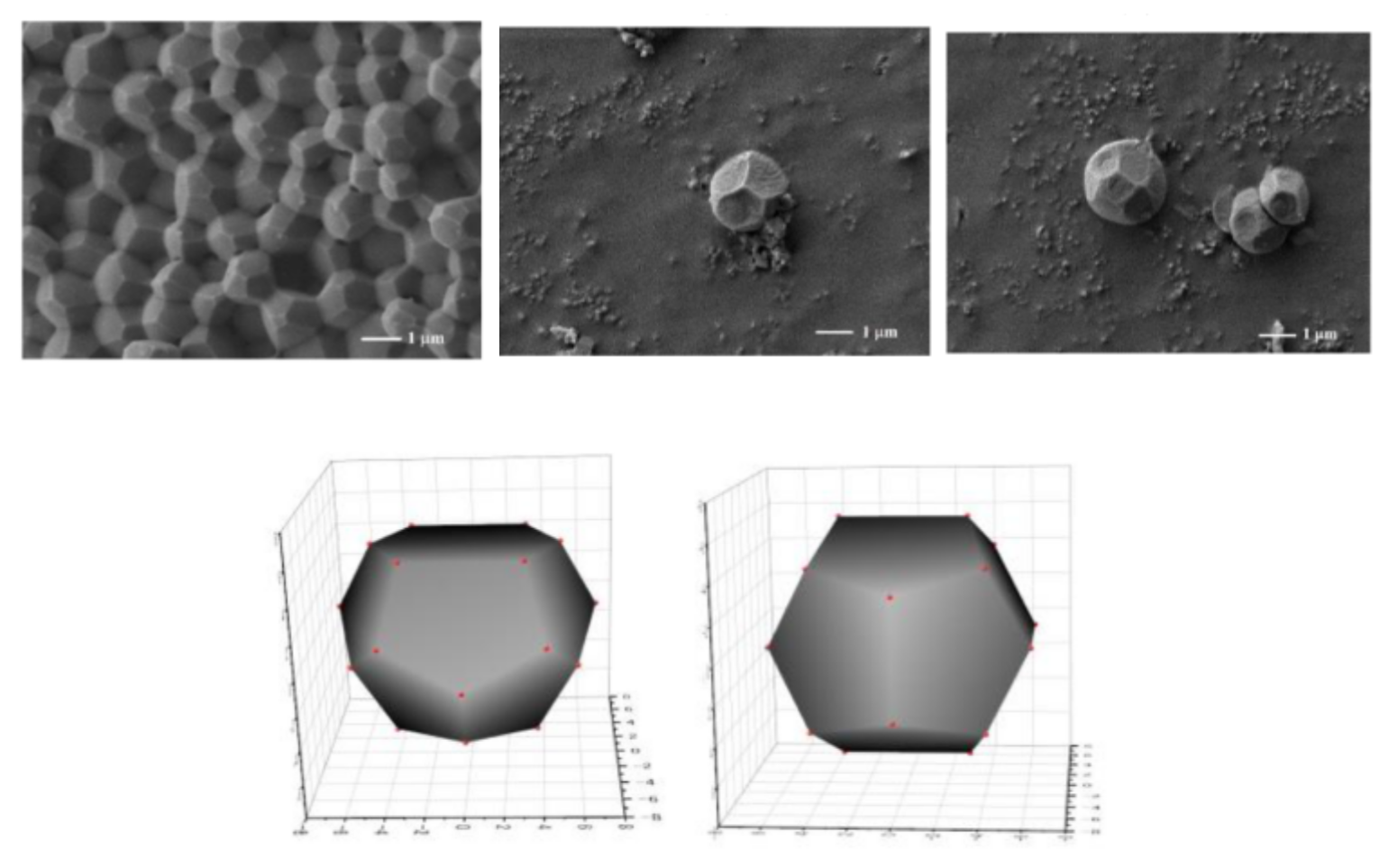Reviewed by Alex SmithNov 29 2022
Weaire–Phelan structures are one-of-a-kind 3D structures that effectively tile a space into equal volumes while using the least amount of surface area. So far, just two occurrences of Weaire–Phelan structures in physical systems have been discovered, and none have been produced using organic materials.
 Polymerization-induced phase separation-based synthesis of Weaire–Phelan structures. Researchers from Japan have constructed, for the first time, a Weaire–Phelan structure using organic materials based on a joint-and-linker concept-based polymerization. (Top row) Images of PEMP-HDI network polymers 35 %wt (sample 3) under SEM (Bottom row). The tetrakaidecahedron and dodecahedron polyhedrons in the theoretical Weaire–Phelan structure. Image Credit: Naofumi Naga from SIT, Japan.
Polymerization-induced phase separation-based synthesis of Weaire–Phelan structures. Researchers from Japan have constructed, for the first time, a Weaire–Phelan structure using organic materials based on a joint-and-linker concept-based polymerization. (Top row) Images of PEMP-HDI network polymers 35 %wt (sample 3) under SEM (Bottom row). The tetrakaidecahedron and dodecahedron polyhedrons in the theoretical Weaire–Phelan structure. Image Credit: Naofumi Naga from SIT, Japan.
Scientists from Japan have created the first polymeric Weaire–Phelan structures utilizing polymerization-induced phase changes, setting the way for the creation of innovative materials with previously unknown capabilities.
Tiling or tessellation is a fascinating class of geometry problems in which a surface or three-dimensional space is enclosed using one or more geometric shapes with no overlaps or gaps in between. The “Kelvin problem,” named after Lord Kelvin, who resolved it, is one such tessellation problem that concerns the “tessellation of space into cells of equal volume with the least surface area.”
The solution, now known as the Kelvin structure, is a convex uniform honeycomb structure constructed by a bi-truncated octahedron. For nearly a century, the Kelvin structure was assumed to be the most effective form in the context of the Kelvin problem until Weaire and Phelan discovered an even more efficient form, known as “the Weaire-Phelan structure,” through computer simulation.
The Weaire–Phelan structure is composed of two types of cells: a tetrakaidecahedron with two hexagonal and twelve pentagonal phases, and an irregular dodecahedron with pentagonal sides, with equal volumes in both cells.
The structure is constructed by arranging 3/4 of the tetrakaidecahedron cells and 1/4 of the dodecahedron cells in a specified pattern. The Weaire–Phelan structure has only been found in two real-world instances: liquid foam generated from a detergent solution and palladium (Pd)-lead (Pb) alloy. Surprisingly, a Weaire–Phelan structure comprised of organic materials like polymers has never been created.
Recently, a team of researchers from Japan has risen to the occasion by creating the first polymeric Weaire–Phelan structure using simple synthetic processes. Prof. Naofumi Naga of Shibaura Institute of Technology spearheaded this study, which was published on November 9th, 2022, in the journal Scientific Reports.
Through the Joint Usage/Research Center Program, the research was carried out in partnership with Prof. Tamaki Nakano of Hokkaido University (MEXT).
The Weaire–Phelan structure was built using a network of polythiourethane for polymerization-induced phase separation.
The proposed Weaire-Phelan structure has closely packed uniform particles of the order of micrometers; this has never been achieved before. This is the first example of a Weaire-Phelan structure made from a polymer species and of a solid-polymer cubic honeycomb created by polymerization-induced phase separation.
Naofumi Naga, Professor, Shibaura Institute of Technology
The polymer was created using a simple polyaddition reaction involving two compounds: tetrakis (3-mercaptopropionate) (PEMP) and hexamethylene diisocyanate (HDI). This approach is based on the joint-and-linker approach, in which a multifunctional monomer supports as the joint source monomer, and an α,ω-bifunctional monomer acts as the linker source monomer, resulting in the formation of a polymer network.
As a result, the “joint” source monomer was PEMP, a multifunctional primary thiol, and the “linker” source monomer was HDI, a diisocyanate. Triethylamine (TEA), which functioned as the base catalyst in toluene, was present during the reaction.
The group created three samples with monomer concentrations of 25, 30, and 35 wt%, naming them samples 1, 2, and 3. They discovered that sample 3 had space-filling polyhedron particles on its surface with hexagonal and pentagonal faces, which corresponded to the polyhedrons of the Weaire–Phelan structure.
Furthermore, 3D scanning electron microscopy was utilized to investigate the polyhedron structure of sample 3, revealing structures of space-filling polyhedrons that exactly matched the polyhedrons of the Weaire–Phelan structure.
The cubic honeycomb proposed by Kelvin was thus formed for the Weaire–Phelan structure in this work. The material synthesized in this work could potentially have applications in photonics, separation, catalysis, nanomedicine, and structural materials based on the new synthetic methodologies and structural concepts. This could open up a new direction of research for the development of advanced materials with unforeseen functions.
Naofumi Naga, Professor, Shibaura Institute of Technology
Journal Reference:
Naga, N., et al. (2022) The first space-filling polyhedrons of polymer cubic cells originated from Weaire-Phelan structure created by polymerization induced phase separation. Scientific Reports. doi.org/10.1038/s41598-022-22058-7.